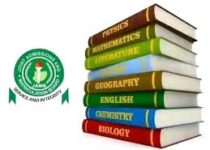WAEC Data Processing Syllabus 2026/2027 & Textbooks
The WAEC Data Processing syllabus 2026/2027 covers topics like the history of computers, data and information concepts, computer components, processing, transmission, internet technologies, operating systems, and productivity tools like word processing, spreadsheets, and databases.
Contents
WAEC Data Processing Syllabus 2026/2027 Objective
- i.Candidates should be taught the acquisition of basic skills in data processing and management.
- ii. Candidates should attend a level of competence in ICT applications that will promote the acquisition of entrepreneurial skills for everyday living in the global world;
- iii. Candidates will be equipped with the core knowledge in the application of ICT in facilitating business transactions and education;
- iv. Candidate must prepare for further studies in Data Processing and Management.
WAEC Data Processing Marking Guide 2026/2027
There will be two papers, Papers 1 and 2 both of which shall be taken as a composite paper at one sitting.
Paper 1: 40 multiple-choice questions, to be answered in 1 hour for 40 marks.
Paper 2:
- Section A: Four essay questions; candidates must answer three in 1 hour for 30 marks.
- Section B: Practical work test with two compulsory essay questions to be answered in 1 hour for 40 marks.
Total of five questions to be answered across both sections.
WAEC Data Processing Syllabus 2026/2027
| WAEC DATA PROCESSING SYLLABUS | ||
| SN | TOPIC | OBJECTIVE |
| 1 | INFORMATION AGE | i. Computing devices. ii. Concept of Number system in computing. iii. Generations of Computer: first, second, third, fourth, fifth generations of computer. |
| 2 | DATA AND INFORMATION | i. Definition of data and information. ii. Types of Data. iii. Ways of handling Data. iv. Definition of Data. v. Digitalization. |
| 3 | BASIC COMPUTING – Classification of computers | i. Classify computers by: Type, Size, Usage. |
| 4 | APPLICATION OF ICT IN EVERYDAY LIFE | i. Uses of ICT in everyday activities. ii. Impact of ICT in the society. |
| 5 | COMPONENTS OF COMPUTER | i. Input Devices. ii. Output Devices. iii. System Unit. iv. Storage Devices |
| 6 | INFORMATION PROCESSING – The art of information processing | i. Definition of Information Processing. ii. Steps involved in Information Processing |
| 7 | INFORMATION TRANSMISSION – Process of information transmission | i. Definition of information transmission. ii. Methods of transmitting information. |
| 8 | MEDIUM OF INFORMATION TRANSMISSION | i. Types of Information Transmission. ii. Classification of means of transmission |
| 9 | NETWORKING | i. Meaning of Networking, Internet and Intranet. ii. Types of Networking |
| 10 | INTERNET | i. Definition of Internet. ii. Benefits of Internet iii. Internet browsers iv. Internet security v. Abuse of the Internet |
| 11 | TOOLS FOR PROCESSING INFORMATION – Operating system | i. Definition of Operating System. ii. Types of Operating Systems. iii. Examples of Operating Systems. iv. Functions of Operating System. |
| 12 | WORD PROCESSING | i. Definition of Word Processing. ii. Uses of Word Processing iii. Examples of word Processing software. iv. Starting, loading and exiting word processing v. Creating, saving and retrieving documents |
| 13 | SPREAD SHEET | i. Definition. ii. Uses. iii. Examples of Spreadsheet Applications. iv. Loading and exiting spreadsheets. v. Creating, saving and retrieving Spreadsheet files. |
| 14 | DATABASE MANAGEMENT SYSTEM | i. Definition. ii. Uses. iii. Examples of Database Applications. iv. Loading and exiting DBMS. v. Creating, saving and retrieving database files. |
| 15 | PRESENTATION PACKAGES | i. Definition, uses examples. ii. Loading and exiting Presentation programs. iii. Creating, saving and retrieving presentation files. |
| 16 | WEB DESIGN PACKAGES | i. Definition. ii. Uses. iii. Components. iv. Examples. |
| 17 | GRAPHIC PACKAGES | i. Definition. ii. Uses of Graphic software packages. iii. Examples of graphic packages. |
| 18 | COMPUTER MAINTENANCE, ETHICS AND HUMAN ISSUES | i. General Cleaning. ii. Battery Charging and replacement for portable systems and UPS. iii. DVD drive lens cleaning. iv. Details of Hardware maintenance. v. Details of Software maintenance. vi. Computer crash and data recovery. |
| 19 | COMPUTER ETHICS | i. Computer room management ethics. ii. Laboratory rules and regulations. |
| 20 | SAFETY MEASURES | i. The sitting arrangement. ii. Positioning of the monitor, keyboard, CPU, mouse and any other peripheral devices. iii. Illuminating the computer room. iv. Maintaining a dust-free environment. v. Keep liquid away from the computer room. |
| 21 | CAREER OPPORTUNITIES IN DATA PROCESSING | i. Professions in computer. ii. Qualities of a good data processing professional. iii. Computer professional bodies. |
| 22 | COMPUTER VIRUS | i. Definition. ii. Types/Examples. iii. Sources. iv. Signals of virus warning v. Virus prevention, detection and deletion |
| 23 | DATA MANAGEMENT – Relational Model | i. Database and table creation using application packages. ii. Creating relationships between tables iii. Creation of forms, queries and report |
| 24 | FILE ORGANIZATION | i. Definition of File organization. ii. Types of File organization |
| 25 | DATABASE SECURITY | i. Concept of data security, access control and data encryption. ii. Role of a database administrator. |
| 26 | PARALLEL AND DISTRIBUTION DATABASE | i. Basic concept of parallel and distributed database. ii. Storing data in a distributed database (DBM) |
Recent Posts
- WAEC Animal Husbandry Syllabus 2026/2027 & Textbooks
- WAEC Yoruba Syllabus 2026/2027 & Textbooks
- WAEC Book-Keeping Syllabus 2026/2027 & Textbooks
- WAEC Marketing Syllabus 2026/2027 & Textbooks
- WAEC Chemistry Syllabus 2026/2027 & Texbooks
- WAEC Arabic Syllabus 2026/2027 & Textbooks
- WAEC Syllabus For Economics 2026/2027 & Textbooks
- WAEC Literature-in-English Syllabus 2026/2027 & Textbooks
- WAEC Igbo Syllabus 2026/2027 & Textbooks
- WAEC Islamic Religious Studies (IRS) Syllabus 2026/2027
- WAEC Government Syllabus 2026/2027 and Textbooks
- WAEC Arabic Syllabus 2026/2027 & Textbooks


